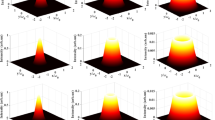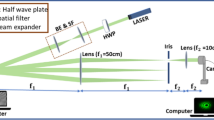Abstract
A true Bessel beam is a family of diffraction-free beams. Thus the most interesting and attractive characteristic of such beam is non-diffracting propagation. In optics, the comparisons of maximum propagation distance had been done between Bessel and Gaussian beams by Durnin and Sprangle, respectively. However, the results obtained by them are conflict due to the difference between their criteria. Because Bessel beams have many potential applications in millimeter wave bands, therefore, it is necessary and significant that the comparison is carried out at these bands. A new contrast criterion at millimeter wavelengths is proposed in our paper. Under this criterion, the numerical results are presented and a new conclusion is drawn.





Similar content being viewed by others
References
J. Durnin, “Exact solutions for nondiffracting beams. I. the scalar theory”. J. Opt. Soc. Am. A. 4(4), 651–654 (1987).
S. W. Li, and T. Aruga, “Long focal depth imaging over a long range”. J. Commun. Res. Lab 46(4), 309–310 (1999).
K. Wang, L. Zeng, and Ch. Yin, “Influence of the incident wave-front on intensity distribution of the nondiffracting beam used in large-scale measurement”. Opt. Commun 216, 99–103 (2003).
J. Durnin, J. J. Miceli, and J. H. Eberly Jr., “Comparison of Bessel and Gaussian beams”. Opt. Lett. 13(2), 79–80 (1988).
P. Sprangle, and B. Hafizi, “Comment on nondiffracting beams”. Phys. Rev. Lett 66(6), 837 (1991).
Y. Z. Yu and W. B. Dou, “Generation of Bessel beams at mm- and submm-wave bands using binary optical elements,” 2008 Global Symposium on Millimeter Waves, 115–118 (2008).
Y. Z. Yu, and W. B. Dou, “Generation of Bessel beams at mm- and sub mm-wavelengths by binary optical elements”. Int. J. Infrared Milli. Waves 29(7), 693–703 (2008).
Y. Z. Yu, and W. B. Dou, “Properties of approximate Bessel beams at millimeter wavelengths generated by fractal conical lens”. Progress In Electromagnetics Research, PIER 87, 105–115 (2008).
Y. Z. Yu, and W. B. Dou, “Generation of mm- and Sub mm-wave Bessel beams using DOE’s designed by BOR-FDTD method and MGA,” J. Infrared Milli. Terahz Waves 30(2), 172–182 (2009).
Z. P. Jiang, Q. S. Lu, and Z. J. Liu, “Propagation of apertured Bessel beam”. Appl. Opt 34(31), 7183–7185 (1995).
J. A. Stratton, Electromagnetic Theory. (McGraw-Hill, NewYork, 1941).
Acknowledgments
This work is supported by the Natural Science Foundation of Fujian Province of China (No.A0610027), and the key project of Quanzhou city science and technology Program (No.2008G13).
Author information
Authors and Affiliations
Corresponding author
Rights and permissions
About this article
Cite this article
Lin, M., Yu, Y. A Comparison of Propagation Between Apertured Bessel and Gaussian beams. J Infrared Milli Terahz Waves 30, 410–416 (2009). https://doi.org/10.1007/s10762-009-9464-z
Received:
Accepted:
Published:
Issue Date:
DOI: https://doi.org/10.1007/s10762-009-9464-z




